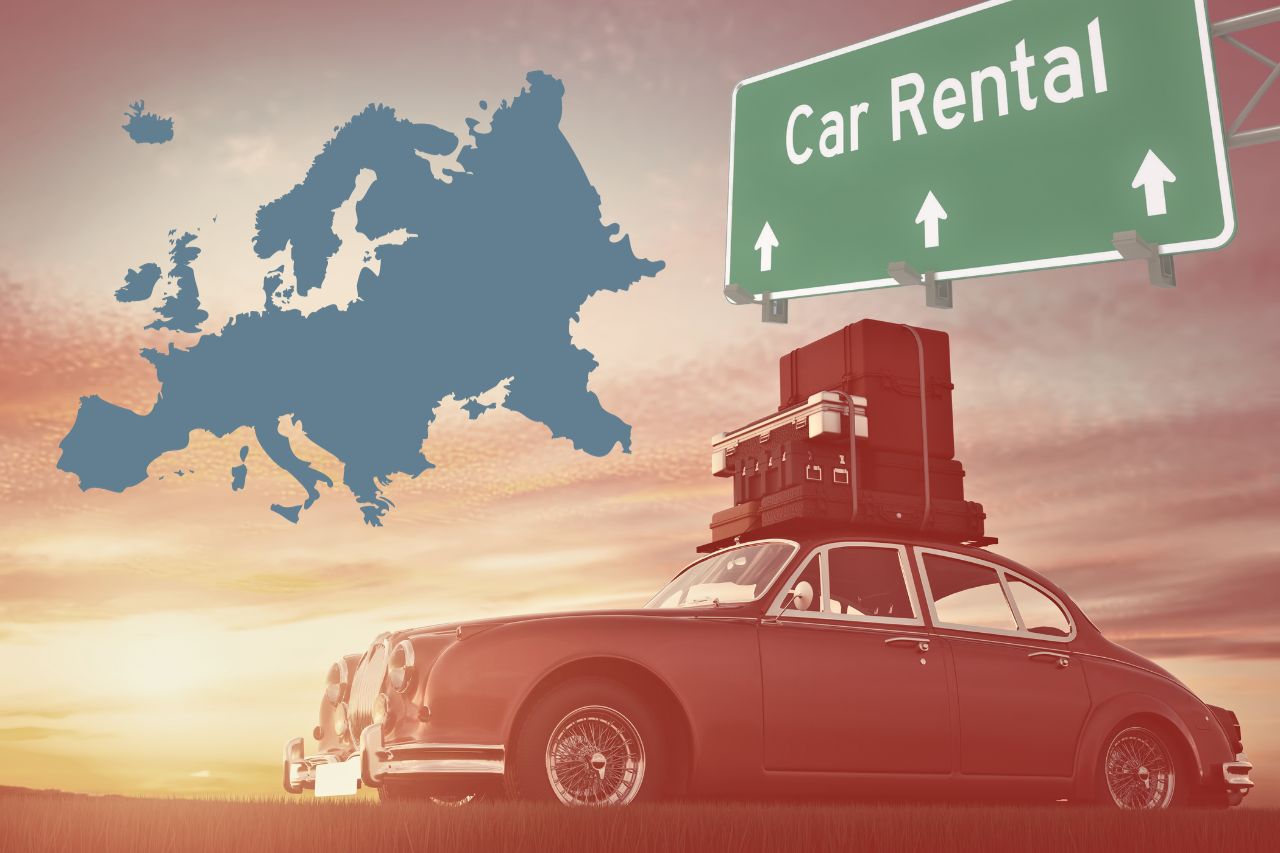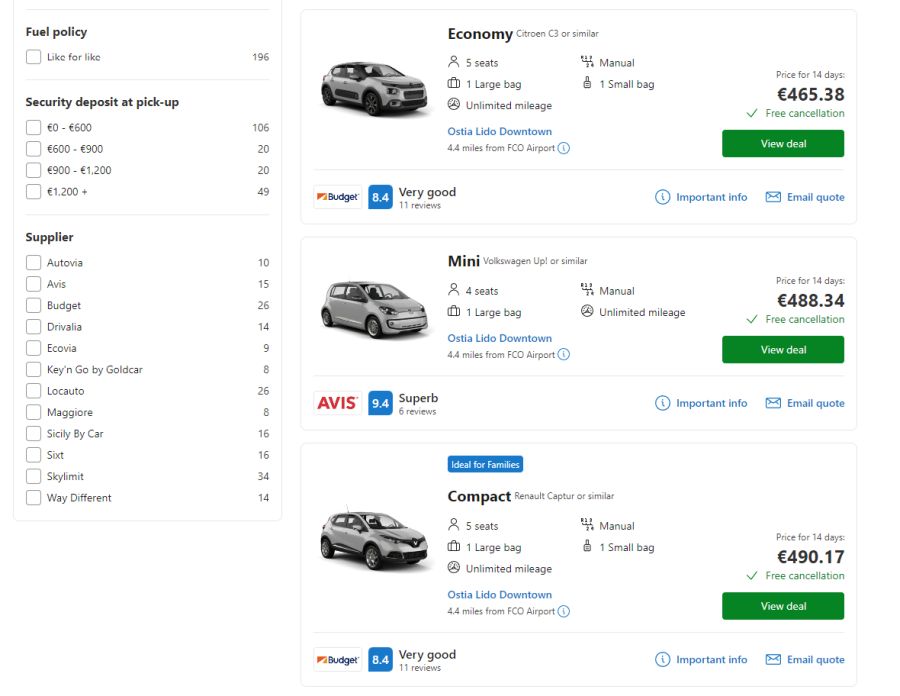This article contains affiliate links. If you make a booking through these links, I may earn a commission, supporting this blog. Rest assured, my recommendations are based on honest assessments, and using these links doesn’t affect prices for you. Thank you for your support!
Planning to rent a car in Europe for the first time? This comprehensive guide walks beginners through the step-by-step process, highlighting the differences from renting in the USA or Canada.
Discover how to easily reserve online, select insurance, and review rental conditions. From car pickup to managing tolls and return procedures, we provide insights on every aspect of renting a car in Europe.
Table of Contents
1. Making a Reservation: The First Step to Rent a Car in Europe
Start by making a reservation with a car rental company. The most convenient way is to do this online.
For this example, I will use rentalcars.com, where you can compare different car rentals. Let’s try to book a car for a 2-week period at Léonard-de-Vinci Airport in Rome.
2. What Type of Vehicle is The Best Choice to Rent a Car in Europe?
I’m searching for a compact or economy car, as it is usually the best option. It’s spacious enough for luggage, comfortable for driving around, and easy to park.
If you prefer an SUV, note that it will be a small crossover, not a full-size Suburban. Choosing a mid-size SUV like the Audi Q5 will come at a 2-3 times higher cost than a compact or small SUV.
IMPORTANT: In Europe, most rental cars come with manual transmission. If you are going to rent a car in Europe as an American and prefer an automatic transmission, be prepared to pay a little extra.
Make sure to select the automatic transmission option in your search to find the right rental car for your needs.
3. Reviewing Rental Conditions to Avoid Extra Fees
This is crucial, especially when using aggregators like rentalcars, to carefully review all rental conditions. The car I considered required a €300 deposit, which is standard, but in case of an accident, there’s a €1000 out-of-pocket expense and €1900 in case of theft.
Moreover, the rental company is situated outside the airport, and you’ll need to arrange your own transportation there.
After checking the map, I discovered it’s a 30-minute bus ride or a 15-minute taxi drive – a deal-breaker for me after a long flight from America. Fortunately, it wasn’t challenging to find other options right at the airport, so I’ll be choosing one of them instead.
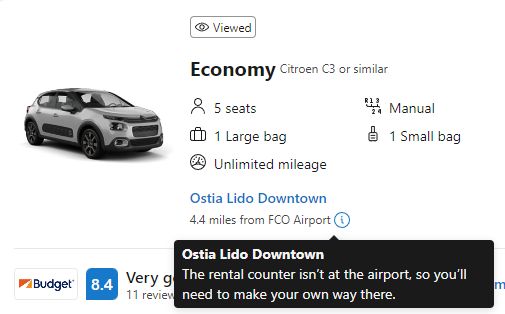
4. Checking Total Car Rental Price for Optimal Transparency
Here’s a breakdown of all the fees and taxes you have to pay to rent a car in Europe. The initial price was nearly €700, but it appears that all fees and insurance are already included in this cost.
However, in the event of damage or theft, you would be responsible for covering up to €1200 or €1800 out of your own pocket. It’s important to note that your standard car insurance or credit card insurance may not cover these expenses.
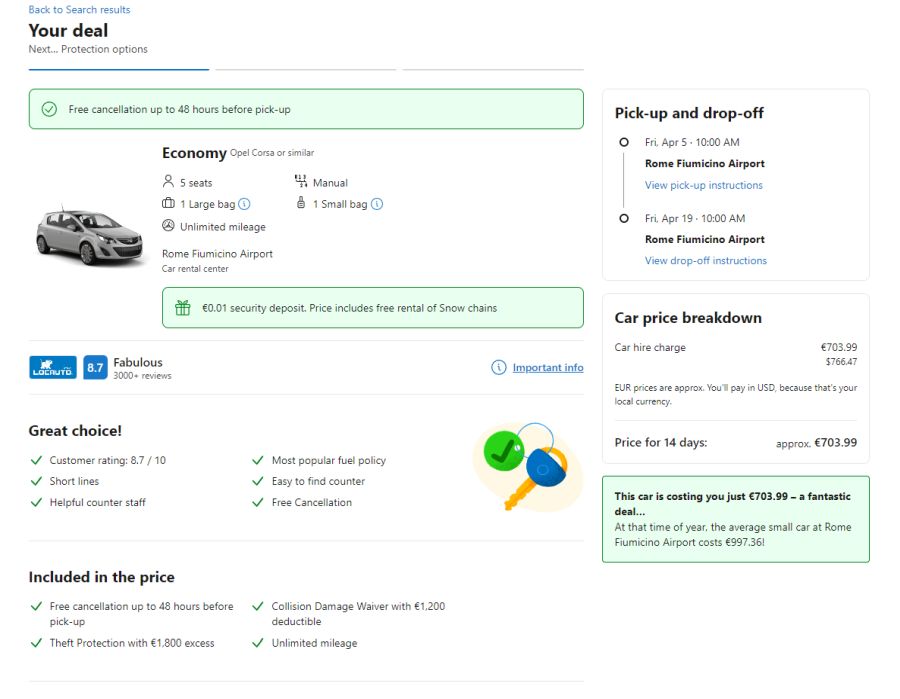
5. Selecting the Best Insurance Coverage to Rent a Car in Europe
On the next screen, they inquire about insurance. As mentioned earlier, we already have Collision Damage Waiver and Third-Party Liability included, albeit with high out-of-pocket limits. While we are mostly covered for significant damages, smaller incidents will be our responsibility.
However, there’s an option to cover such costs at €109.28 for the entire rental, inclusive of windows, mirrors, wheels, and tires. I’ll opt for that. When you rent a car in Europe, especially in small Italian towns, it’s relatively easy to incur scratches.
On the following screen, I’ll need to provide personal and payment details. Once finalized, I’ll receive a booking confirmation via email. It’s advisable to print it out and have it with you at the counter.
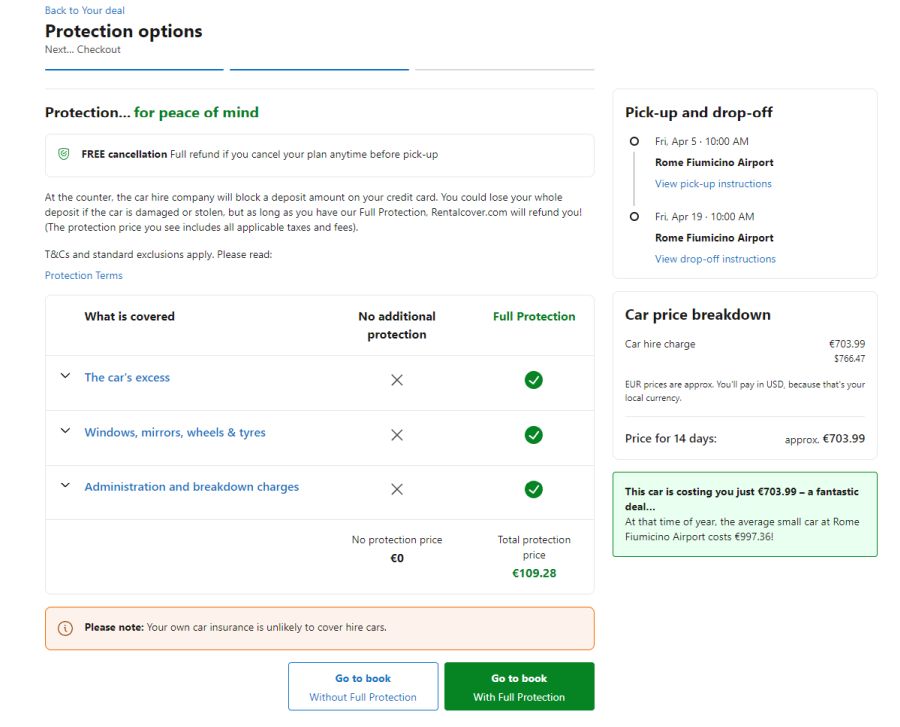
6. Reaching the Car Rental Facility
After landing at the destination airport (FCO in this example), the typical process involves passing through passport control if you arrive from outside of Europe, collecting your luggage, and then heading to the car rental facility.
During peak hours, there might be a wait in line. If your rental facility is situated outside the airport, you’ll either need to use a shuttle bus or arrange your own transportation to get there.
7. At the Car Rental Counter
“When picking up the car, ensure you bring essential documents, typically including a passport, a valid driver’s license, and a credit card in your name for both payment and security.
Upon document verification, you will be asked about preferred insurance options. It’s important to note that if you are from outside of Europe, your car or credit card insurance from your home country will most likely not be applicable here. In this example, we have already selected all the insurance we wanted, so at the counter, we will not add anything more.
Ultimately, it is your choice regarding the kind of insurance you want for peace of mind while driving. After deciding on insurance, you will pay with your card for the rental if you haven’t done it online. Additionally, they will temporarily block a deposit on your credit card for the duration of the rental.
8. Picking Up Your Rental Vehicle
Most likely, you’ll receive the car keys directly at the counter, which differs from America, where you can often choose your car from the available options in the parking lot. Here, you’ll be provided with the specific location of your assigned car in the parking lot.
If you’re dissatisfied with the assigned vehicle, you can return to the counter and attempt to replace it, but be aware that it might take some time.
In most cases, the rental company prepares a car for each customer, so they might not have another one readily available. I once changed a car in Italy and received a better one, but it wasn’t cleaned yet, and I had to wait at least 30 minutes for them to prepare it.
Before leaving the parking lot, carefully inspect the vehicle for any existing damage. Note down any scratches, dents, or issues, and ensure the rental company acknowledges them in writing.
This step is crucial to avoid disputes about responsibility for damage later on. Unlike in the USA, my experience is that in Europe, they do check the vehicle upon return, so be thorough in noting all scratches to avoid additional fees.
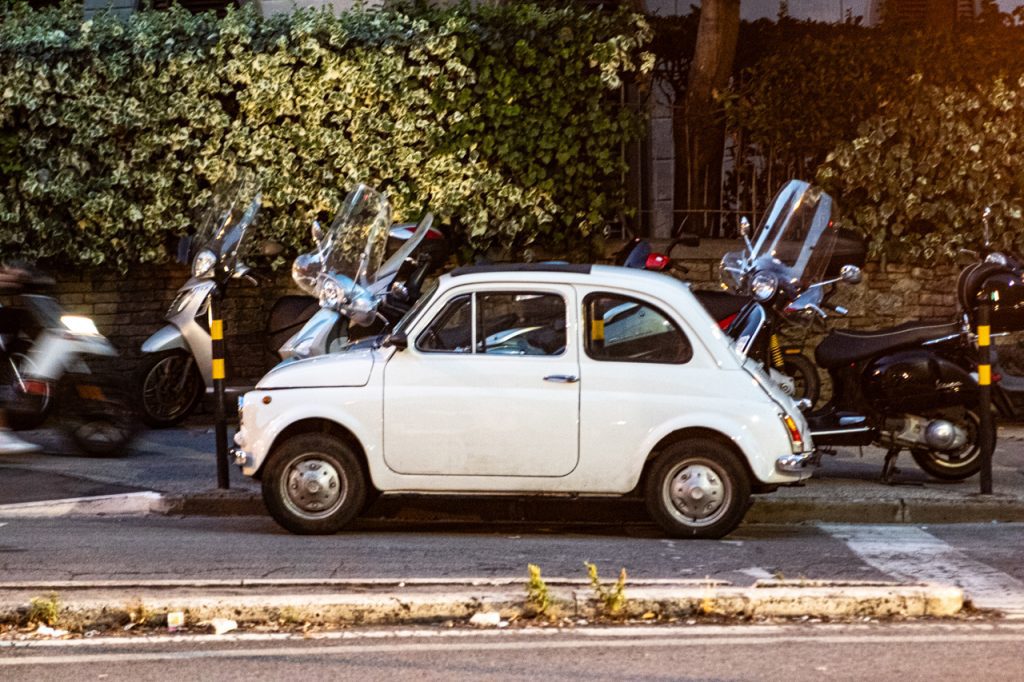

9. Leaving the Parking Lot
After checking the vehicle’s condition, you can pack your luggage and head towards the exit. In most cases, there won’t even be a gate, as you have already completed all the paperwork – so you are good to hit the road!
10. Tips During Your Car Rental Period
During the rental, as you rent a car in Europe, you are responsible for the vehicle. It is your responsibility to refuel and adhere to traffic rules. If you receive a speeding ticket, you will be responsible for it – not the rental car company.
In fact, the rental company may charge you an additional fee for processing the ticket, making you accountable for both the ticket and the fee.
Another important consideration is tolls. You are required to cover toll expenses, and if you pass through toll roads with automatic payment systems, the rental company will charge you a processing fee for that as well.
In Europe, many freeways require payment, and the method varies by country. Depending on the location, it could involve:
- Paying at the gate: When you enter or leave a freeway, you pay at the counter (example: Italy).
- Vignette: Before driving on certain roads, you need to buy a vignette, allowing you to use freeways for a specified time (week, year, etc.). This can be done online or at gas stations (example: Austria, Switzerland, Slovenia, Czech Republic, Slovakia, Hungary).
- Automatic payment system: This system, which I’ve only encountered in Portugal, is installed in every rental car. You only need to allow the rental company to charge your credit card for these payments.


11. Returning Your Rental Car
Return the car at the scheduled time or earlier. Ensure the fuel tank is filled to the specified level, typically a full tank.
There’s no need to refuel right before reaching the airport; you can conveniently do so within a 50 km radius from the rental facility, ensuring the fuel gauge indicates a full tank.
The rental agency will examine the vehicle, and if all is well, you’ll handle any extra fees and get back your deposit.
What is The Cost to Rent a Car in Europe? Summary of All Expenses
Here’s a summary of the total rental costs for a two-week period for the selected car in Europe:
- €703.99 – Base car rental cost
- €109.28 – Additional insurance
- €400 – Fuel cost (based on an assumption of 200 kilometers per day and a gas price of €1.8 per liter)
- €124.80 – Tolls (for a trip from Rome to Venice, Milan, Pisa, and back to Rome)
€1,338.07 – Total price for 2 weeks: Renting a car in Europe costs approximately €100 per day
Can I Rent a Car Cheaper in Europe?
Certainly, finding a car at a more affordable rate is possible. This example aimed to illustrate the entire process, but it’s essential to note that opting for a cheaper option isn’t always the best choice.
In the event of an incident, budget-friendly rental companies might offer subpar customer service or impose additional charges.
While I’ve personally used various rental companies without any issues, it’s worth noting that online, you’ll find complaints about nearly every rental company.
My advice is to carefully review rental conditions beforehand, seek clarification from rental staff if any terms are unclear (especially as a foreigner), drive responsibly, and your rental experience should go smoothly.
If this was helpful for you – book your car using the widget below, it will not affect your price but I will get small commission. Thank you!
Pin it for later!
Here’s everything about renting a car in Europe. I hope this guide proves useful. Now, renting a car in Europe will be hassle-free for you!
Feel free to drop a comment if you have further questions. If you found this post helpful, don’t hesitate to share it!
